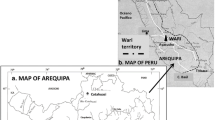Abstract
The k0-based internal mono-standard neutron activation analysis (IM-NAA) method was used to analyze large size archaeological clay brick samples for grouping study. Elemental concentration ratios with respect to Sc were derived using IM-NAA in conjunction with in situ relative detection efficiency. Preliminary grouping was carried out using bi-plot of Ce/Sc and La/Sc ratios and the grouping was confirmed by statistical cluster analysis. Concentration results of a large size sample were compared with analysis of small size replicates by both relative NAA and IM-NAA methods. The method adopted here is a standard-less one for grouping combined with provenance study of archaeological artifacts.




Similar content being viewed by others
References
Ranaweera MP (2004) Ancient stupas in Sri Lanka—Largest brick structures in the world. CHS Newsletter No 70, Construction History Society, London
Padma S (2008) Material culture and the emergence of urban Buddhism in Andhra. In: Padma S, Barber AW (eds) Buddism in the Krishna River valley of Andhra. State University of New York Press, Albany, pp 11–41
Miriello D, Lezzerini M, Chiaravalloti F, Bloise A, Apollaro C, Crisci GM (2013) Replicating the chemical composition of the binder for restoration of historic mortars as an optimization problem. Comput Concr 12:553–563
Guha Thakurta T (2013) The production and reproduction of a monument: the many lives of the Sanchi stupa. South Asian Stud 29:77–109
Lopez-arce P, Garcia-guinea J, Gracia M, Obis J (2003) Bricks in historical buildings of Toledo City: characterisation and restoration. Mater Charact 50:59–68
Tite MS (2008) Ceramic production, provenance and use—a review. Archaeometry 50:216–231
IAEA-1501 (2011) Nuclear techniques for cultural heritage research. IAEA-1501, Vienna
Goffer Z (1983) Physical studies of archaeological materials. RepProg Phys 46:1193–1234
Beal JW, Olmez I (1997) Provenance studies of pottery fragments from Medieval Cairo, Egypt. J Radioanal Nucl Chem 221:9–17
Dasari KB, Acharya R, Lakshmana Das N (2013) Application of INAA to ancient bricks for grouping study using trace elements. J Radioanal Nucl Chem 298:699–705
Bendaoud R, Guilherme A, Zegzouti A, Elaatmani M, Coroado J, Carvalho ML, Queralt I (2013) Elemental mapping of moroccan enameled terracotta tile works (Zellij) based on X-ray micro-analyses. Appl Radiat Isot 82:60–66
Dasari KB, Chhillar S, Acharya R, Ray DK, Behera A, Lakshmana Das N, Pujari PK (2014) Simultaneous determination of Si, Al and Na concentrations by particle induced gamma-ray emission and applications to reference materials and ceramic archaeological artifacts. Nucl Instrum Meth B 399:37–41
Adraens A (2005) Non-destructive analysis and testing of museum objects: an overview of 5 years of research. Spectrochimica Act Part B 60:1503–1516
Dasari KB, Acharya R, Swain KK, Lakshmana Das N, Reddy AVR (2010) Analysis of large and non-standard geometry samples of ancient potteries by internal monostandard neutron activation analysis using in situ detection efficiency. J Radioanal Nucl Chem 286:525–531
Partha Sarathi D, Acharya R, Nair AGC, Lakshminaryana S, Lakshmana Das N, Reddy AVR (2008) Application of instrumental neutron activation analysis for chemical composition analysis of Ancient potteries from Buddhist sites of Andhra Pradesh: part I. J Nucl Radiochem Sci 9:7–12
Vasilopoulou T, Tzika F, Koster-Ammerlaan MJJ, Stamatelatos IE (2011) Large sample neutron activation analysis of a reference inhomogeneous sample. J Radioanal Nucl Chem 289:731–737
Bode P, Overwater RMW, De Goeij JJM (1997) Large sample neutron activation analysis: present status and prospects. J Radioanal Nucl Chem 16:5–11
Sueki K, Kobayashi K, Sato W, Nakahara H, Tomizawa T (1996) Nondestructive determination of major elements in large samples by prompt γ-ray neutron activation analysis. Anal Anal Chem 68:2203–2209
Nair AGC, Acharya R, Sudarshan K, Gangotra S, Reddy AVR, Manohar SB, Goswami A (2003) Development of an internal monostandard instrumental neutron activation analysis method based on in situ detection efficiency for analysis of large and nonstandard geometry samples. Anal Chem 75:4868–4874
Acharya R, Nair AGC, Sudarshan K, Reddy AVR, Goswami A (2007) Development and applications of the k 0-based internal mono standard INAA method. Appl Radiat Isot 65:164–169
Acharya R, Swain KK, Dasari KB, Shinde AD, Pujari PK, Reddy AVR (2014) Application of k 0-based internal monostandard NAA for large sample analysis of clay pottery: as a part of inter comparison exercise. J Radioanal Nucl Chem 300:517–521
Shinde AD, Acharya R, Reddy AVR (2017) Analysis of zirconium and nickel based alloys and zirconium oxides by relative and internal monostandard neutron activation analysis methods. Nucl Eng Tech 49:562–568
De Corte F, Simonits A (2003) Recommended nuclear data for use in the k 0 standardization of neutron activation analysis. Atomic Data Nucl Data Tables 85:47–67
National Nuclear Data Center. http://www.nndc.bnl.gov. Accessed 15 Feb 2018
IAEA RM SL-1 (1999) Reference sheet on “Trace and minor elements in lake sediment Reference Material (RM) IAEA-SL-1, International Atomic Energy Agency (IAEA). IAEA RM SL-1, Vienna
Oliveira PMS, Munita CS, Hazenfratz R (2010) Comparative study between three methods of outlying detection on experimental results. J Radioanal Nucl Chem 283:433–437
Johnson RA, Wichern DW (1992) Applied multivariate statistical analysis, 3rd edn. Prentice Hall, New Jersey
Acknowledgements
Authors from GITAM University thank Dr. P.K. Pujari, Head, Radiochemistry Division, BARC for the support and encouragement. Authors thankfully acknowledge University Grants Commission-Department of Atomic Energy Council of Scientific Research (UGC-DAE CSR), Mumbai Centre for the project and financial assistance and Dr. P. Gayatri, Ex. Director, Department of Archaeology and Museum, united Andhra Pradesh, Hyderabad for providing authentic samples. Authors thank nuclear reactor crew members of the AHWR CF and Dhruva reactor, BARC, Mumbai for their help during sample irradiation.
Author information
Authors and Affiliations
Corresponding authors
Rights and permissions
About this article
Cite this article
Dasari, K.B., Acharya, R. & Das, N.L. Chemical characterization of large size archaeological clay bricks for grouping study by internal mono-standard neutron activation analysis. J Radioanal Nucl Chem 316, 1205–1211 (2018). https://doi.org/10.1007/s10967-018-5863-8
Received:
Published:
Issue Date:
DOI: https://doi.org/10.1007/s10967-018-5863-8




